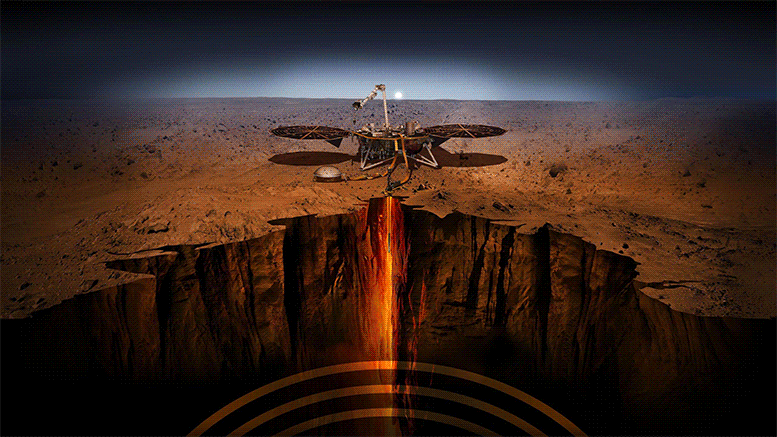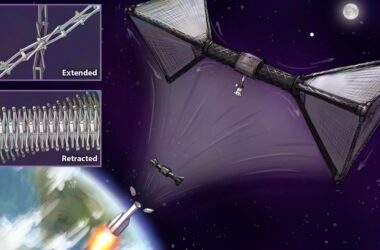
Le télescope Webb est sur le point de commencer sa mission scientifique …
Un regard historique sur le centre de notre galaxie …
Et les astronautes de l’équipage 3 réfléchissent à leur mission … quelques histoires à vous raconter – This Week at NASA!
Le télescope Webb en phase finale d’installation de ses instruments
Le télescope spatial James Webb de la NASA est dans la phase de sa mission connue sous le nom de mise en service des instruments scientifiques. Il s’agit d’environ deux mois d’étalonnages intensifs et du dernier groupe d’activités de configuration requises avant que le télescope ne commence ses observations scientifiques cet été. Une image test récente prise par Webb d’une région du Grand Nuage de Magellan a été comparée à une image de cette même région prise précédemment par notre télescope spatial Spitzer. La comparaison démontre la clarté accrue avec laquelle Webb peut voir le ciel infrarouge. Cette capacité pourrait donner lieu à des vues plus détaillées du cosmos et à des découvertes sans précédent.

Voici la première image de Sgr A*, le trou noir supermassif situé au centre de notre galaxie. C’est la première preuve visuelle directe de la présence de ce trou noir. Elle a été capturée par l’Event Horizon Telescope (EHT), un réseau qui a relié huit observatoires radio existants sur la planète pour former un seul télescope virtuel de la taille de la Terre. Le télescope porte le nom de l’horizon des événements, la limite du trou noir au-delà de laquelle aucune lumière ne peut s’échapper. Crédit : Collaboration EHT
Les télescopes de la NASA contribuent à l’étude des Milky Way’s Black Hole
According to the Event Horizon Telescope Collaboration, this is the first image of the supermassive black hole, known as Sagittarius A *, located at the center of our Milky Way galaxy. The Event Horizon Telescope uses data from a worldwide network of telescopes. Observations from NASA’s Chandra X-ray Observatory, NuSTAR, and Swift Observatory were used to help astronomers study Sagittarius A*.

From left to right, ESA (European Space Agency) astronaut Matthais Maurer, NASA astronauts Tom Marshburn, Raja Chari, and Kayla Barron, are seen inside the SpaceX Crew Dragon Endurance spacecraft onboard the SpaceX Shannon recovery ship shortly after having landed in the Gulf of Mexico off the coast of Tampa, Florida, Friday, May 6, 2022. Maurer, Marshburn, Chari, and Barron are returning after 177 days in space as part of Expeditions 66 and 67 aboard the International Space Station. Credit: NASA/Aubrey Gemignani
Crew-3 Astronauts Discuss Mission After Returning to Earth
The astronauts of NASA’s SpaceX Crew-3 mission reflected on their recent stay aboard the International Space Station during a May 11 news conference. NASA’s Kayla Barron, Raja Chari, and Tom Marshburn, along with Matthias Maurer of the European Space Agency, spent 175 days aboard the station conducting microgravity science research and technology demonstrations.
“It was just this awe-inspiring experience and incredible honor to represent the NASA team and family in that role, and also to have our relationships as a crew grow through that expeditionary living and really supporting each other so that we could get the most out of every single day in terms of accomplishing our mission.”—Kayla Barron, NASA Astronaut
Crew-3 splashed down May 6 off the coast of Florida in SpaceX’s Crew Dragon “Endurance” spacecraft.

An artist illustration of the InSight lander on Mars. InSight, short for Interior Exploration using Seismic Investigations, Geodesy and Heat Transport, is designed to give the Red Planet its first thorough checkup since it formed 4.5 billion years ago. Credit: NASA/JPL-Caltech Credit: NASA/JPL-Caltech
NASA’s InSight Records Monster Quake on Mars
Our InSight lander on Mars has detected the largest quake ever observed on another planet. The estimated magnitude 5 quake occurred earlier this month, on May 4. The largest “Marsquake” previously recorded by InSight was an estimated magnitude 4.2 detected on August 25, 2021. A magnitude 5 quake is comparable to a medium-size quake on Earth but is close to the upper limit of what scientists hoped to see on Mars during InSight’s mission.

Arabidopsis plants 6 days after the seeds were planted. The four wells on the left contain plants growing in JSC-1A lunar soil simulant. The three wells on the right contain plants growing in lunar soils collected during the Apollo 11, 12, and 17 missions. Credit: UF/IFAS photo by Tyler Jones
NASA-funded Study Grows Plants in Soil From the Moon
For the first time ever, researchers have grown the hardy and well-studied plant Arabidopsis thaliana in nutrient-poor lunar regolith samples collected during several Apollo Moon missions. The plant is a relative of mustard greens, broccoli, cauliflower, and Brussel sprouts. This NASA-funded study could help pave the way for future astronauts to someday grow more nutrient-rich plants on the Moon and elsewhere in deep space.
The Hunga Tonga-Hunga Ha’apai eruption on January 15, 2022, caused many effects, some illustrated here, that were felt around the world and even into space. Some of those effects, like extreme winds and unusual electric currents were picked up by NASA’s ICON mission and ESA’s (the European Space Agency) Swarm. Image not to scale. Credit: NASA’s Goddard Space Flight Center/Mary Pat Hrybyk-Keith
NASA Mission Finds Tonga Volcanic Eruption Effects Reached Space
Data from NASA’s ICON mission has helped researchers determine that effects from the volcanic eruption on the South Pacific island of Hunga Tonga-Hunga Ha‘apai in January 2022, actually reached beyond Earth – into space. The data show that in the hours after the eruption, hurricane-speed winds and unusual electric currents formed in the ionosphere – Earth’s electrified upper atmospheric layer at the edge of space. ICON launched in 2019 to identify how Earth’s weather interacts with weather from space.
That’s what’s up this week @NASA …


